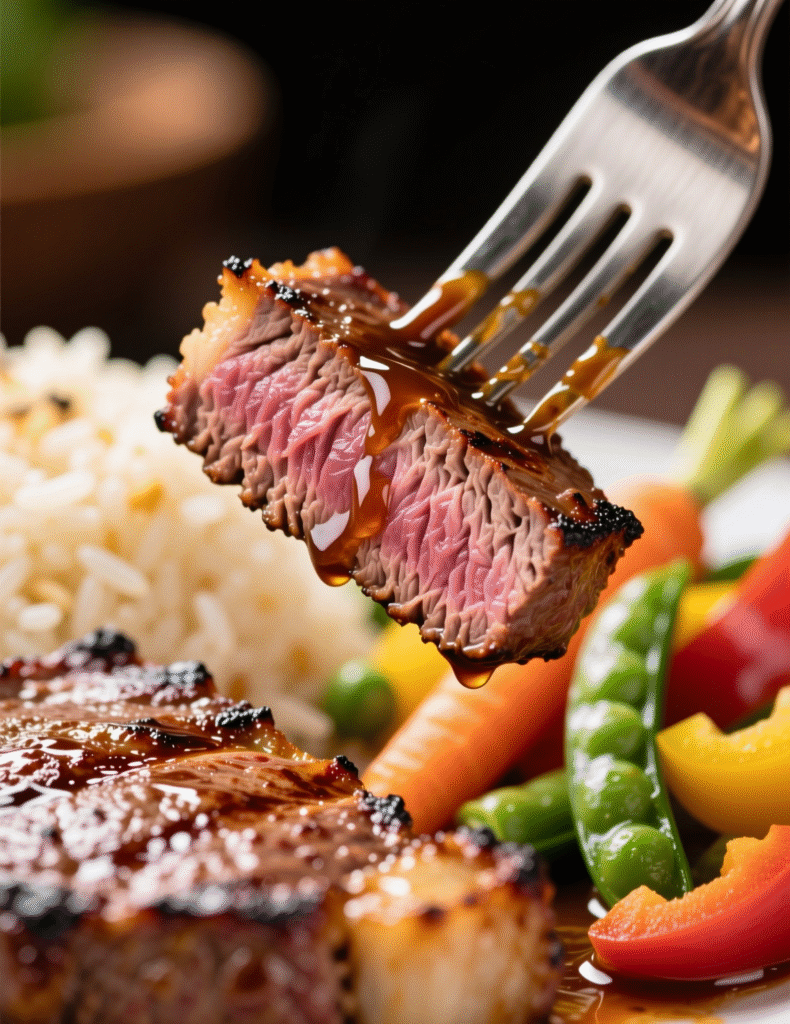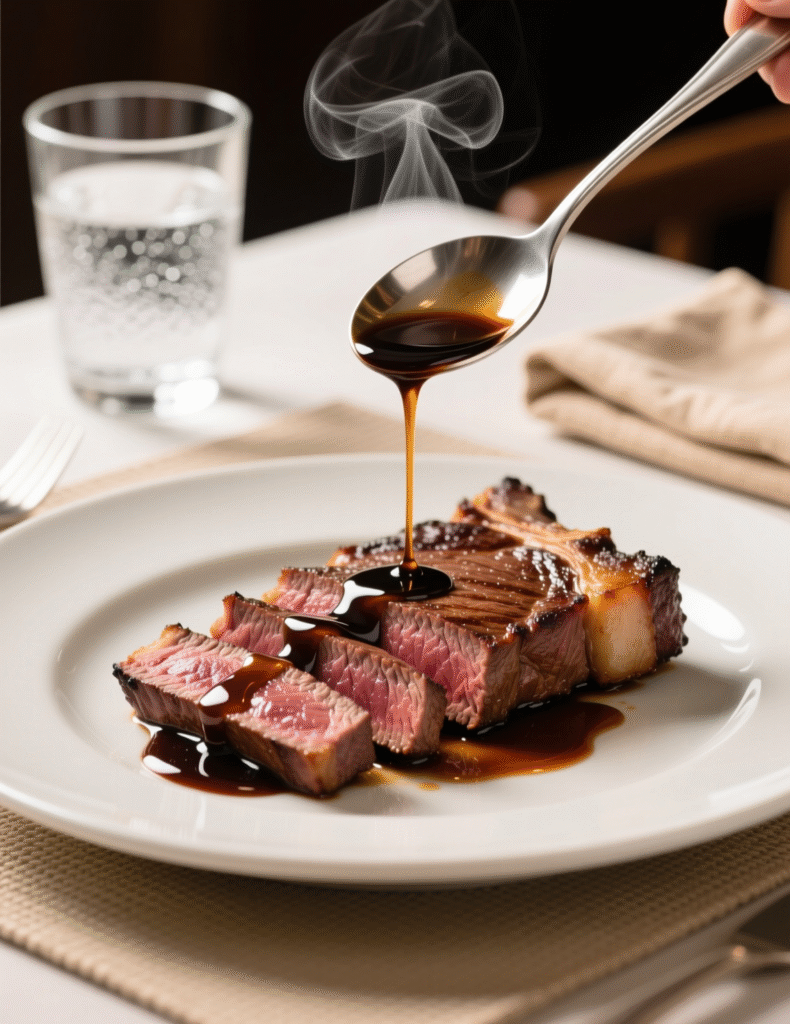You can almost smell it, can’t you? That smoky, slightly charred aroma that hits the air just before a perfectly seared flank steak lands on the cutting board. Flank steak — lean, fibrous, and beautifully beefy — is a cut that rewards patience and precision. When paired with the right soy-based marinade, it turns into something irresistibly tender and juicy. Not everyone gets it right, though. I’ve seen many good cuts ruined by over-marinating, poor slicing, or weak heat control. Let’s fix that today.
This isn’t your usual “throw some soy sauce and garlic together” recipe. We’re diving into how to build real flavor, how to understand muscle fibers, and how to turn a modest cut into a restaurant-level steak.
Understanding the Flank Steak
Flank steak comes from the lower chest area of the cow, just beneath the loin. It’s long, flat, and rich in muscle fibers that run in one direction — which is why it’s crucial to slice it against the grain. If you’ve ever bitten into a chewy steak and wondered what went wrong, it was probably sliced the wrong way.
It’s a cut that demands respect. Unlike tenderloin or ribeye, flank steak isn’t naturally tender. But with a clever marinade, it becomes something deeply flavorful. It absorbs flavors better than most cuts because of its open-grain structure. Think of it like a sponge — only meatier and a lot more delicious when grilled.
The Science Behind the Soy Marinade
Let’s talk chemistry for a sec. Soy sauce is more than just salt in liquid form. It’s a complex mix of amino acids, glutamates, and natural sugars created through fermentation. These elements enhance umami — the “savory” taste that makes foods like aged cheese, mushrooms, and grilled meat taste irresistible.
When soy sauce combines with acid (like lime juice or vinegar), oil, and aromatics, it begins to break down some of the proteins in the steak, tenderizing the meat from the outside in. But don’t go too far. Over-marinating — say, more than 12 hours — can make the outer layer mushy. You want the flavor to infuse without compromising the texture.
Ingredients That Matter
For 4 servings, here’s what you’ll need:
- 1 ½ pounds (about 680g) flank steak
- ½ cup soy sauce (use low-sodium if you prefer balance)
- 3 tablespoons olive oil
- 2 tablespoons brown sugar or honey
- 3 cloves garlic, minced
- 1 tablespoon grated fresh ginger
- 2 tablespoons rice vinegar or lime juice
- 1 teaspoon toasted sesame oil (optional but heavenly)
- ½ teaspoon crushed red pepper flakes (for a bit of kick)
- Freshly ground black pepper to taste
Optional garnish: chopped scallions, sesame seeds, or a sprinkle of flaky sea salt.
Now, before anyone says, “That’s a lot of soy sauce,” remember — this is a marinade, not a sauce. Most of it won’t end up in your final dish. It’s there to season, to soften, and to coat the fibers with deep, savory notes.

Crafting the Perfect Marinade
Whisk everything together in a non-reactive bowl or resealable bag. I prefer a glass bowl; I can see how the color and consistency develop. When you mix it right, it should smell bold — salty, sweet, aromatic, and slightly tangy.
Pour it over the steak, ensuring every inch is coated. Press out any air if using a bag, then seal it tight. Let it rest in the fridge for at least 2 hours, ideally around 6. Overnight is fine too, but no longer than 12 hours. The soy and acid will do their job well before then.
Here’s a small trick I’ve learned: if you want a more pronounced char and deeper crust, pat the steak dry with paper towels before grilling. The drier the surface, the better the Maillard reaction — that magical browning process that creates flavor and texture.
Grilling or Pan-Searing Like a Pro
When it comes to cooking, flank steak thrives on high heat. You can grill, broil, or sear it in a cast-iron pan. Just make sure your surface is hot — really hot. You should hear that satisfying sizzle the moment the steak hits.
If you’re grilling, preheat to medium-high (around 450°F / 230°C). Cook each side for about 4–5 minutes depending on thickness, aiming for medium-rare to medium. The internal temperature should be around 130–135°F (54–57°C) for that pink, juicy center.
For stovetop cooking, a cast-iron pan works best. Heat a touch of oil until shimmering, then sear each side until browned. Don’t move the steak too soon — give it time to develop that crust. Patience here is flavor.
Resting: The Step Most Home Cooks Skip
After cooking, resist the urge to slice immediately. Let it rest for 8–10 minutes, loosely covered with foil. This lets the juices redistribute through the meat instead of spilling all over the cutting board.
When it’s time to slice, position your knife at a 45-degree angle and cut against the grain. You’ll see those muscle fibers clearly — slice across them for maximum tenderness.
A quick drizzle of the reserved marinade (boiled for safety, of course) can bring an extra layer of flavor if you like.
The Flavor Profile — Umami in Harmony
This steak isn’t shy. The soy brings salt and depth, the ginger adds freshness, and the garlic gives punch. The sugar caramelizes just enough on the edges, creating that sweet-savory balance that keeps you coming back for another bite.
It’s got an Asian-inspired backbone but can pair with nearly anything — roasted potatoes, grilled asparagus, or a sesame cucumber salad. You could even thinly slice leftovers for sandwiches or stir-fry.
Expert Tips That Change Everything
- Score the steak lightly before marinating. Shallow cuts help the flavors penetrate deeper. Don’t go too deep or you’ll lose juices during cooking.
- Control your salt. If using full-sodium soy sauce, skip extra salt elsewhere.
- Use fresh ginger, not powder. Powdered ginger lacks that sharp aroma and subtle heat that fresh root brings.
- Don’t crowd your pan or grill. Flank steak needs space for heat to circulate evenly.
- Rest before slicing. I’ll say it twice because it matters that much.
The Nutritional Breakdown
A 4-ounce (113g) serving of flank steak offers roughly 180 calories, 23g of protein, and about 8g of fat. It’s leaner than ribeye but packed with iron, zinc, and vitamin B12 — all vital for energy metabolism and muscle health.
Soy-based marinades also add trace minerals and antioxidants from the fermented soybeans. Just be mindful of sodium levels if you’re watching your intake. Using low-sodium soy or cutting back a tablespoon won’t hurt the flavor much.
Why Flank Steak Deserves More Love
Here’s the thing: flank steak used to be the underdog of the butcher counter. It was cheap, tough, and often overlooked. But once chefs began showcasing its versatility — think fajitas, stir-fries, salads — it quickly became a favorite.
It’s economical, cooks fast, and shines under strong flavors. And unlike premium cuts, it doesn’t need fancy treatment. Just time, heat, and the right balance of sweet, salty, and tangy.
Common Mistakes to Avoid
Many home cooks overcook flank steak out of fear it won’t be safe at lower temps. But going beyond medium can dry it out fast. Medium-rare is the sweet spot.
Another misstep? Forgetting to slice thinly. Thick slices feel rubbery because of the grain structure. Thin slices melt in your mouth.
Also, don’t reuse marinade as a sauce unless you boil it. It’s raw-meat territory — unsafe unless heated thoroughly for at least 3–5 minutes.
Variations and Creative Twists
Once you master the base, experiment. Add a splash of orange juice for brightness. Or swap honey for maple syrup for a more caramel tone. A spoonful of gochujang (Korean chili paste) brings heat and umami depth.
You can even turn this into a rice bowl. Lay thin slices over jasmine rice, drizzle with sesame oil, and top with pickled onions and scallions. It’s comfort in a bowl.
If you’re doing tacos, slice the steak thinner and serve with charred peppers, cilantro, and a squeeze of lime. Simple, vibrant, perfect for weeknights.

Pairing Ideas
This dish loves contrast. Pair it with something fresh or starchy to balance the umami.
- Grilled corn with chili-lime butter adds smokiness and zest.
- Asian slaw with cabbage, carrots, and sesame dressing brings crunch and acidity.
- Roasted garlic mashed potatoes give creamy relief to the robust flavors.
And if you’re sipping something alongside — a medium-bodied red like Malbec or a cold Japanese beer works wonders.
The Professional Angle
In restaurant settings, flank steak shines as a high-margin, high-impact dish. Its lean profile and short cooking time make it ideal for dinner services. Many chefs sous vide it first at 131°F (55°C) for two hours before a hard sear, guaranteeing tenderness every time.
That method locks in moisture while giving precise doneness. If you’ve got the gear, it’s worth the effort. But even without sous vide, traditional grilling — done right — delivers incredible results.
The Final Word
A well-cooked flank steak isn’t just a meal; it’s a small triumph. It’s the kind of dish that makes you appreciate what technique and patience can do.
This Juicy Flank Steak with Soy Marinade proves that flavor doesn’t need to come from expensive cuts or complicated sauces. It’s about balance — the dance of salt, sweetness, acidity, and heat.
So, next time you’re by the grill or stove, give this cut the care it deserves. Let it sizzle, rest, and shine. Because when done right, one bite will make you rethink what “juicy steak” really means.
FAQs
How long should I marinate flank steak in soy marinade?
Ideally between 2 to 6 hours, but no longer than 12 hours to prevent mushy texture.
Can I use regular soy sauce instead of low-sodium?
Yes, but reduce other salty ingredients to keep the balance right.
What’s the best way to cook flank steak?
High heat grilling or pan-searing works best for a juicy, charred exterior.
Should I slice flank steak before or after cooking?
Always slice after cooking and resting, against the grain for tenderness.
Can I reuse the leftover marinade?
Only if it’s boiled first to kill any bacteria from raw meat.
What internal temperature should flank steak reach?
Cook to 130–135°F for medium-rare or 140°F for medium.
Why is my flank steak tough?
It’s likely overcooked or sliced with the grain instead of against it.
Can I make this recipe without a grill?
Absolutely, a cast-iron pan or broiler gives great results too.
What side dishes go well with soy-marinated flank steak?
Try roasted veggies, Asian slaw, or garlic mashed potatoes.
Can I freeze marinated flank steak?
Yes, freeze it in the marinade for up to 2 months; thaw before cooking.

Marie Smith is a passionate recipe blogger, sharing easy, delicious, and creative culinary ideas that inspire home cooks to elevate everyday meals with flavor and simplicity.
